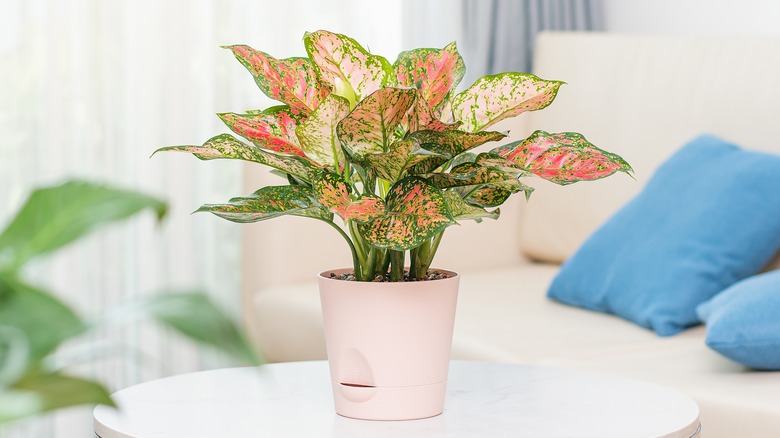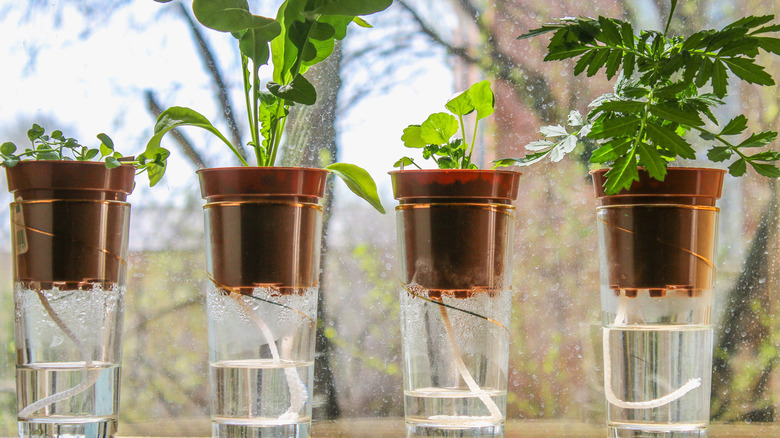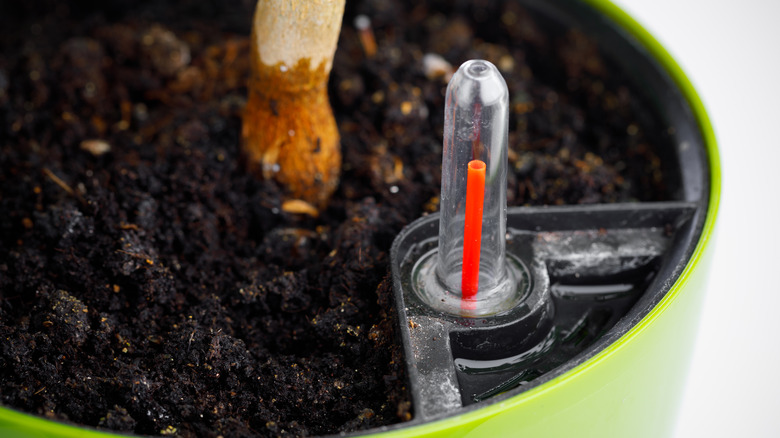Mistakes To Avoid With Your Self-Watering Planters
If you've ever struggled to stay on top of watering your houseplants, chances are you've bought (or considered buying) a self-watering planter. They're convenient and time-saving, allowing you to go much longer without watering your plants. Unfortunately, they're also widely misused, so much so that viral videos on TikTok say self-watering systems aren't worth it. In reality, self-watering planters can be a helpful and worthwhile tool as long as you avoid common mistakes like relying too much on the self-watering mechanism.
Self-watering planters allow plant roots to continuously access water from a reservoir system on the bottom or side of the pot. Through a phenomenon called "capillary action," water is wicked from the reservoir into the potting mix, keeping the soil moist but not drenched. This allows you to be more hands-off than if you watered the old-fashioned way, from the top with a watering can. Plants that would normally need near-daily watering can go weeks in a self-watering planter before they need a refill.
However, the process is still not completely hands-off — maintaining a self-watering planter your plants will love requires more than just filling the reservoir and letting the roots do their thing. As long as the reservoir has water in it, the soil will stay moist; it's not a fine-tuned science, so it can't account for individual plant preferences. Putting the wrong plants in a self-watering planter or not keeping an eye on the amount of water they get are also common mistakes that give self-watering planters a bad rep.
Don't rely completely on the self-watering system
Self-watering planters are often touted as a way to keep your plants watered while you're on vacation. That may be true in some cases, but the length of time that a planter can keep a plant alive depends on the specific plant, the size of the water reservoir, and the soil mix. Think of the planter more as a handy water storage system rather than a device that allows a plant to water itself as needed (still waiting on that invention).
You shouldn't necessarily keep the reservoir constantly filled for all plants; on the flip side, you can't go too long without checking it, lest it dry out. The ideal frequency and amount of water to add to a self-watering planter depends on the plant. Does it like to dry out between waterings? If so, allow that to happen before you refill the reservoir, and consider adding less water at a time so the pot has time to dry out before your next watering day.
To determine the right refill schedule, monitor the system to see how long it typically takes for the water to run out. If, for example, you discover that the water reservoir gets empty after a few days and the plant requires consistently moist soil, relying on that system during a week-long vacation is a mistake. Keep in mind that humidity and rainfall can also affect how quickly the soil dries out throughout the year. If a plant seems to be drinking water more slowly than usual, that can also be a sign that it's not getting enough light.
Don't use the wrong plants or soil
Plants that prefer moist soil are ideal candidates for self-watering planters since you can provide up to a few weeks of water in one go. Those that need to thoroughly dry out between waterings or prefer drier soil overall, such as cacti or succulents, can be grown in self-watering planters as well, but you'll have to carefully control the amount of water in the reservoir and use the right potting mix. Soil that stays moist for too long can be a death sentence for these plants.
Plants that need tons of water may also struggle because self-watering systems may not evenly distribute moisture to the top of the soil as well as the bottom. For the same reason, young plants will need additional top watering until their roots have grown deep enough to reach the water from the reservoir. Avoid adding too many plants or too-large plants into one self-watering system, as the reservoir may not be big enough to provide adequate water.
Substrates that keep the roots too wet or get easily compacted are a no-go for self-watering systems. Water is already available in abundance in these pots, and too much moisture will deprive the roots of oxygen and kill the plant. Instead, well-draining, chunkier mixes with lots of aeration are ideal. You can mix potting soil with perlite or humus to add aeration. Alternatively, look for a soilless mixture or one that's specifically designed for self-watering planters. When transitioning a plant from a regular pot to a self-watering one, you may need to trim some roots to get rid of the old substrate.


